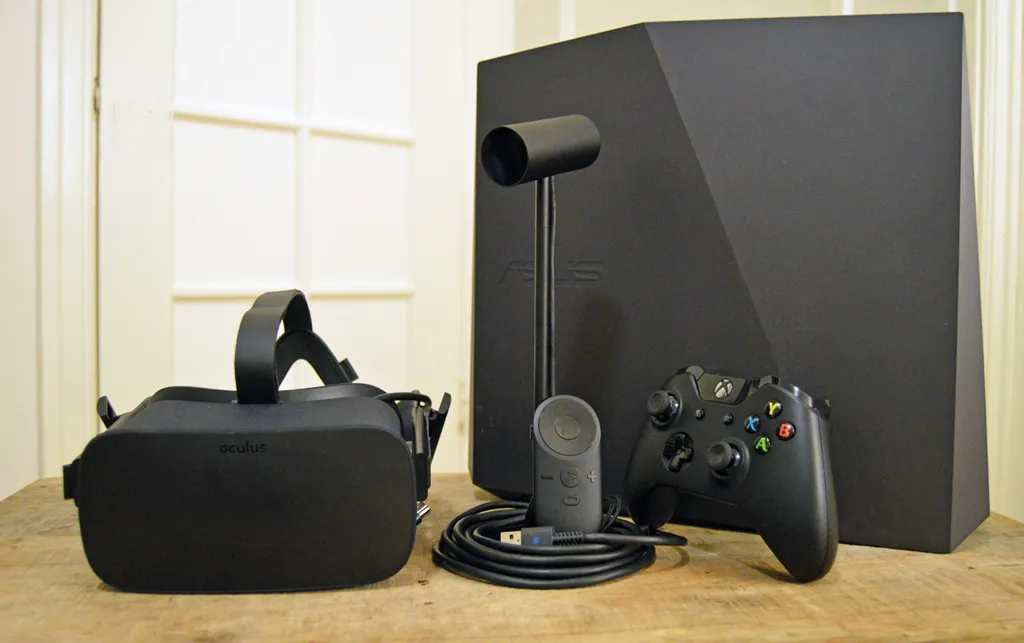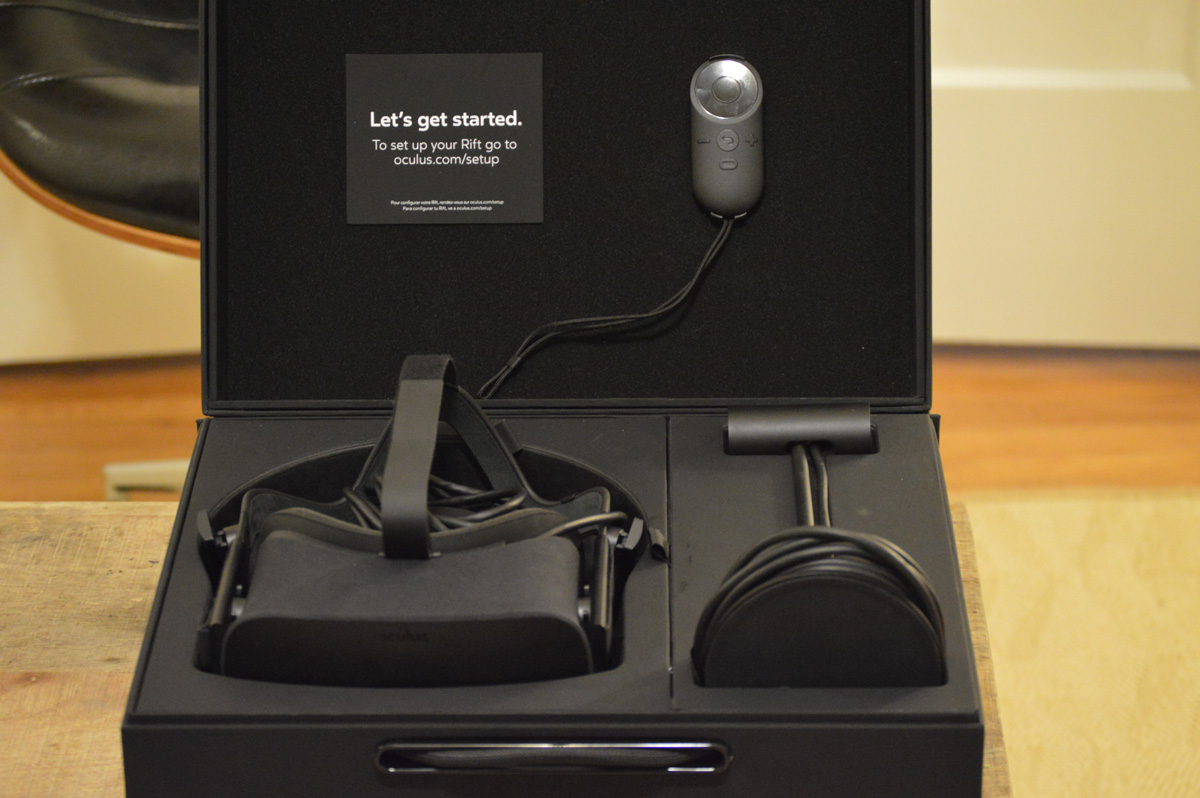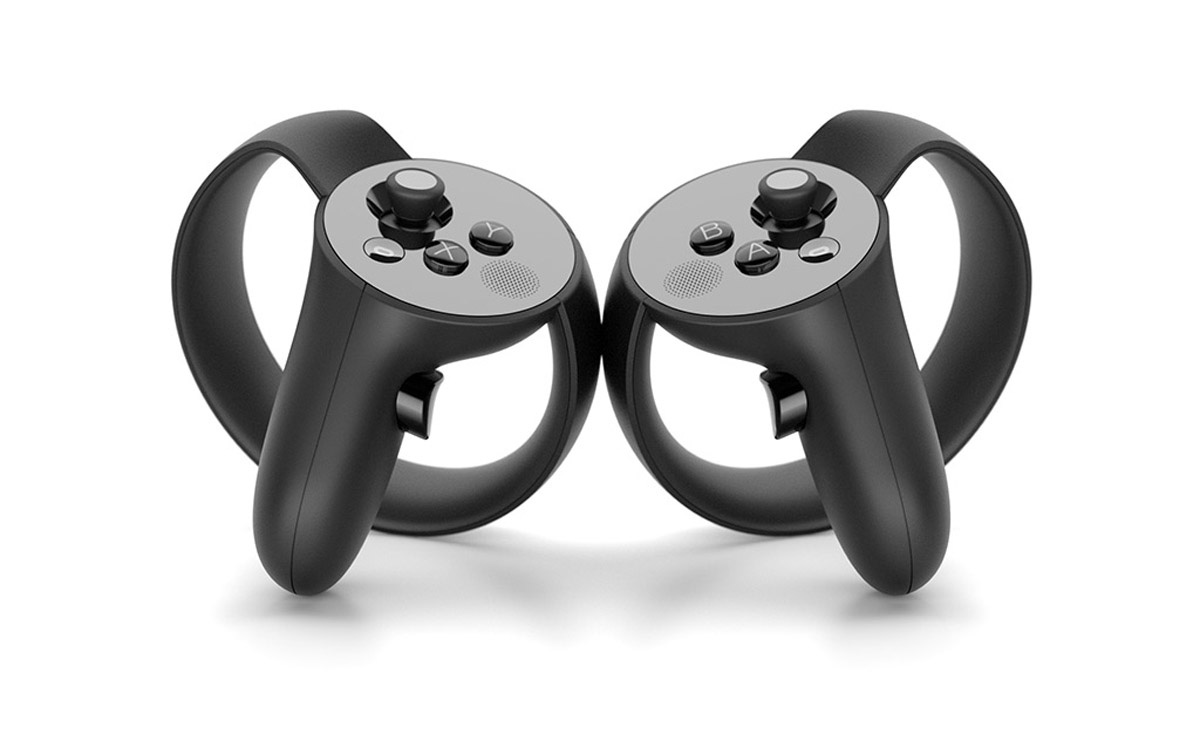A lot has happened in the four years since the team at Oculus first announced the Kickstarter project for the Rift in 2012. An industry once thought to be dead and buried has risen from the ashes like a phoenix with the top technology companies in the world racing to join the ranks. We have seen the technology and content develop at a rapid rate driven by a rabid interest by some of the world’s smartest people in a medium that could change the way we interact with computers (and each other) forever.
Today the phoenix finally takes flight as the age of virtual reality begins with the release of the Oculus Rift.
At $599, (plus potentially another $1000 if you need to upgrade your PC) the Rift isn’t a trivial investment, but after spending over 20 hours with the device over the last week I am certain that it is worth every penny. Everything from the design, to the tracking, to the display, has been improved significantly since the second development kit and the end result is a product that feels ready not just for technology enthusiasts and gamers, but for everyone.
TL;DR The Oculus Rift is an expertly engineered and beautifully designed piece of hardware. While it is missing hand tracked controllers, it makes up for it with excellent content, ease of use, and an incredibly ergonomic form factor. The Oculus Rift is an important first leap for consumer VR, and is worth every penny of the $600 you are going to have to spend to get it.
Table of Contents
- Setup
- Oculus Home
- Ergonomics and Design
- Display and Optics
- Sound
- Tracking Volume and Robustness
- Oculus Remote
- Content
- Tech Specs
- Touch the Future
- Concluding Thoughts
Setup
From the moment you grab the box you can tell that the Rift is a polished consumer product. The packaging represents the same type of sleek minimalistic design that Apple popularized. That same essence is mirrored through the entire product from user experience to hardware design.
Inside the box you will find:
- Oculus Rift headset with integrated headphones and mic
- Oculus Sensor
- Oculus Remote
- Xbox One Wireless Controller (2 AA batteries, adapter and extender included)
- All necessary connection cords and an audio tool to remove/add integrated headphones
A wise person once said, “keep it simple stupid” and that is just what Oculus has done with the Rift – the device’s setup is a breeze.
As soon as you open the box you will see a sticker telling you to visit oculus.com/setup from here you will download and install all the necessary files to run the Rift with a single executable. The whole setup process, including the download and installation, takes about 30 to 60 minutes depending on your internet connection. A series of slides guide you through the best ways to wear the headset and setup your hardware, including a suggestion to clear away nearby furniture – which is key due to the large tracking volume the Rift’s external sensor provides.
The hardware itself connects to the back of the computer using two USB 3.0 ports (one for the headset and one for the tracking sensor) and a single HDMI, which needs to be connected directly into the HDMI port on the graphics card (you can’t use an adapter).
Once the software is installed and the headset is plugged into the computer, you will need to set up an Oculus account. This will allow you to make purchases and find friends within the Oculus platform.
As soon as you login you are prompted to continue in the headset – where you are greeted first by a health and safety warning followed by a demo reel that should look familiar to anyone who had a chance to try the Crescent Bay – a series of short tech demos designed to show off the power of virtual reality to first time visitors. (A fun aside – be sure to look out for a billboard showing Oculus’ founder Palmer Luckey behind you on the skyscraper demo)
Oculus Home
Whether you watch the opening demo reel or skip it, you will find your way to Oculus Home, your launch pad for all things Rift. True to form with virtual reality, Oculus’ storefront and library transports you to a space – rather than simply showing you a menu. For launch, Oculus’ home is a beautiful modern villa, rendered in realtime with a crackling voxel fireplace to the player’s left. In the future this area may be customizable as well.
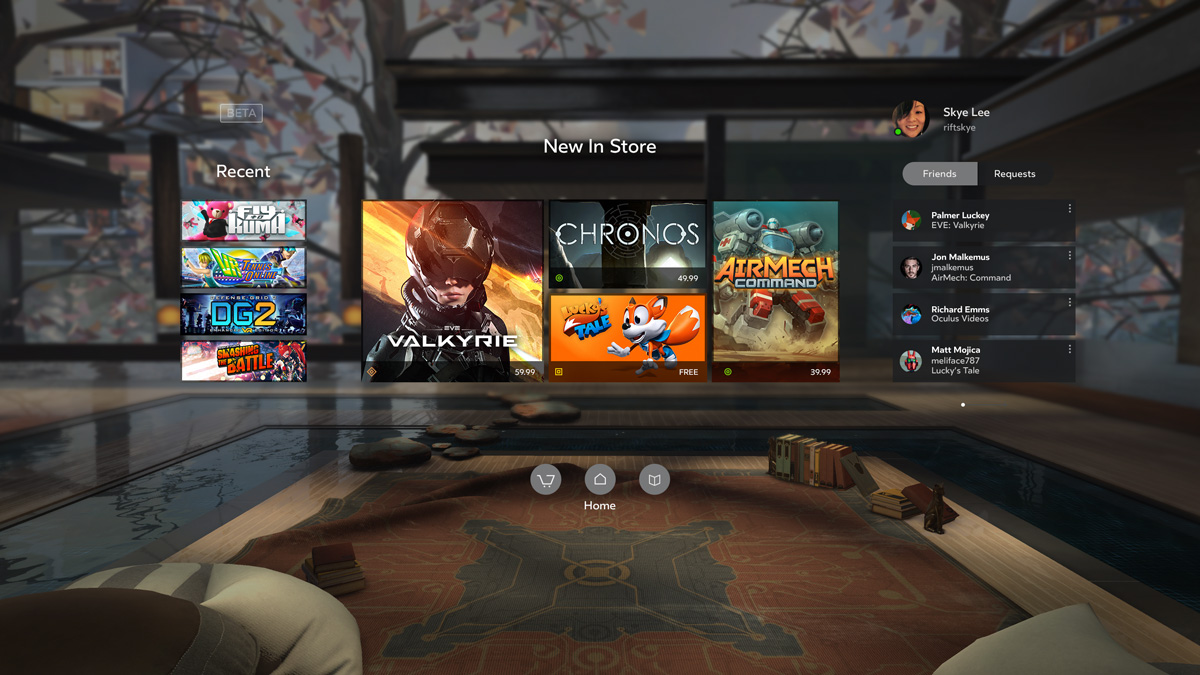
Navigation through the Oculus Home menu is intuitive. Selections are made by gazing at an icon and pressing either A on the Xbox controller or select on the Oculus Remote. The Home page contains three panels: recently played, a featured/new in store section that contains a selection of experiences, and a friends list as well as icons below that allow you to access the store and your library – both of which are also accessible from outside the headset in the desktop client.
Oculus’ storefront is divided into multiple sections including a place for developer experiments known as Concepts (which will seek to replace the now defunct Oculus Share) and an Early Access section similar to the one on Steam. Highlighting one of the core issues still tied to VR, the titles in the Oculus store are rated on a comfort scale. The scale ranges from “Comfortable” experiences which “involve little or no movement, [and are] often stationary” such as Air Mech: Command or Defense Grid 2 to “Intense” experiences that have “complex movement” like ADR1FT or EVE: Valkyrie. It’s a smart decision by Oculus because it allows people who may be sensitive to motion sickness the opportunity to avoid having a bad experience. As an aside, in all the time I personally spent in the Rift I only felt my stomach lurch once, during a likely purposeful moment in ADR1FT, but I most definitely have my “VR legs” under me.
Ergonomics and Design
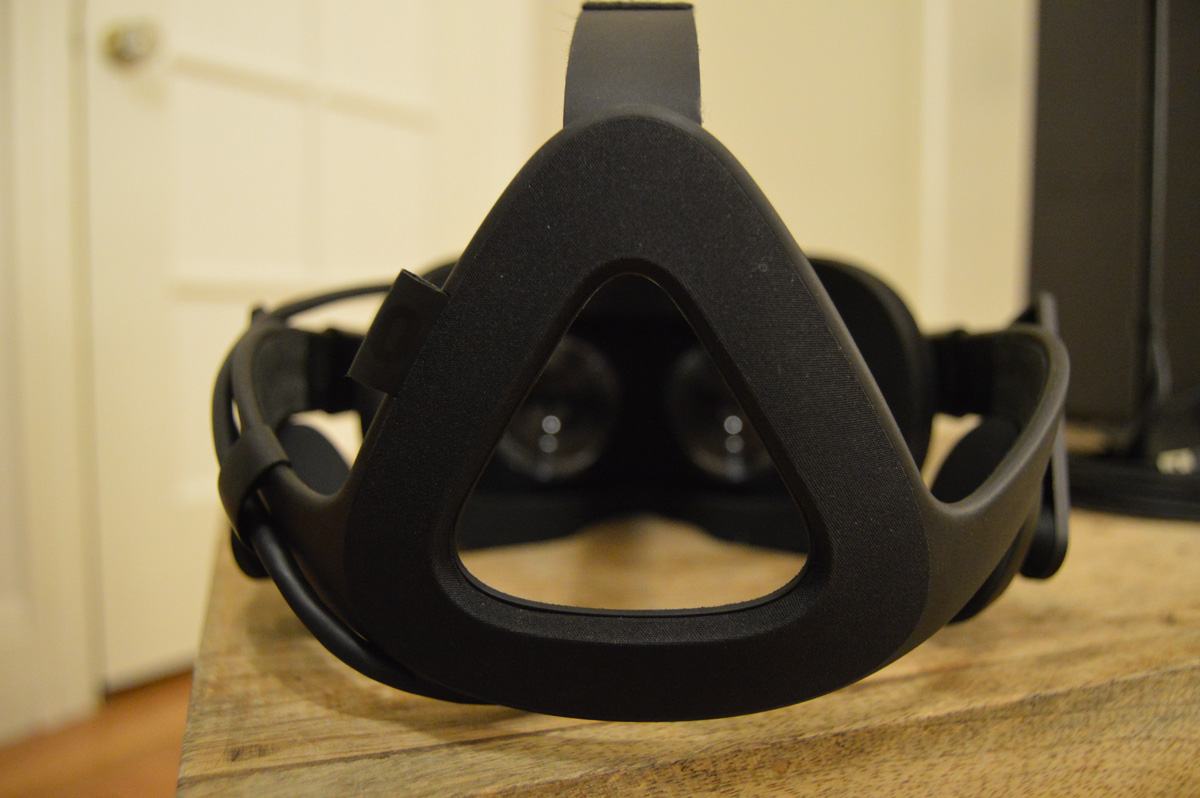
Putting the headset on like a baseball cap, the Rift fits very comfortably over the head. Interchangeable facial interfaces make wearing glasses under the headset more comfortable, however the one that comes with the headset was a bit small for my larger framed glasses. Two rigid extendable arms on each side and a strap on top allow you to quickly adjust the fit to your head, which is important because the headset does have a relatively small sweet spot, meaning that getting it to sit just right is very important to having a clear, focused image.
The consumer version feels lightweight and extremely well balanced. The headset’s balance allows it to disappear on your face after a while, something that the second development kit struggled with. Whereas I could only wear the DK2 for 30-40 minutes at a time before it became uncomfortable, I was able to wear the final Rift for multiple hours at a time without getting tired.
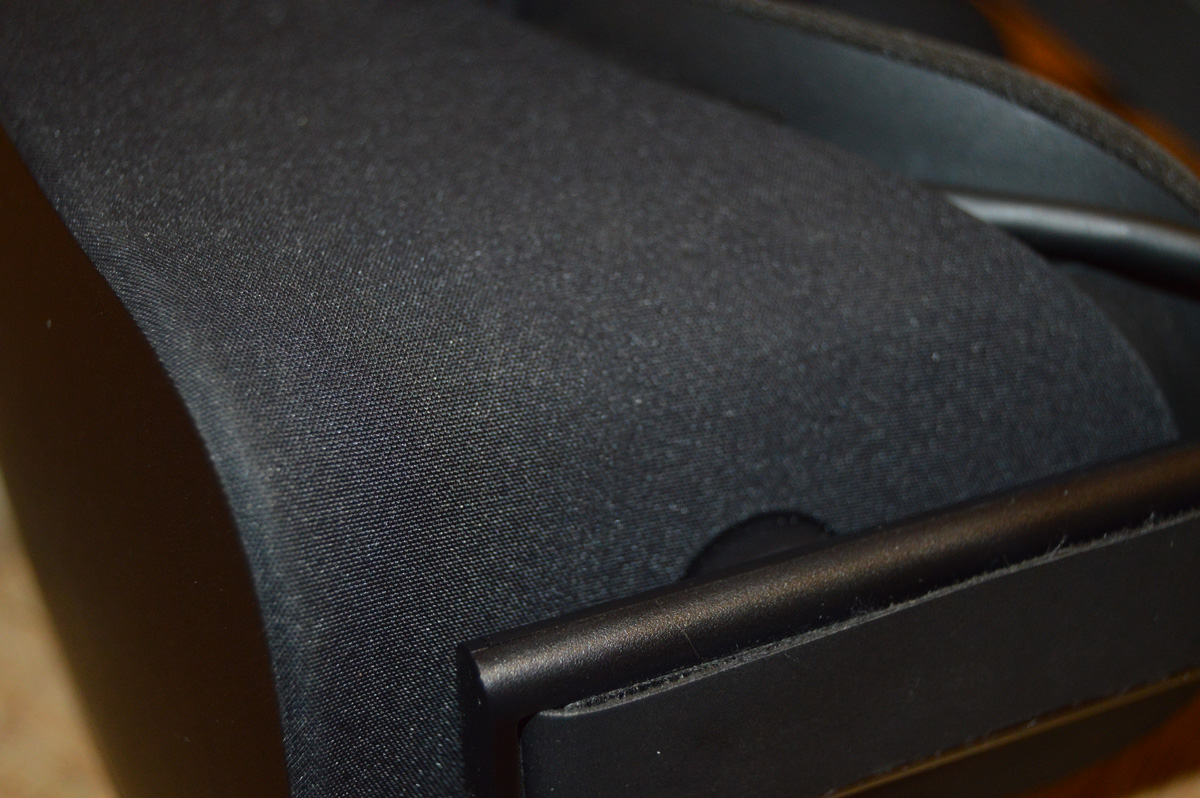
Oculus Rift’s design has also greatly improved since its development kit days. The hard plastic shell has been replaced by a layer of soft, taut fabric that encloses the device. The fabric gives the headset a nice feel, but I’ve also noticed it has a bit of a tendency to get dirty. The tracking camera’s design has also been marketably improved, with a matte black modern design that sits handsomely and unobtrusively either on a desk alongside a monitor, or in a living room.
There have also been a number of functional design refinements such as a light sensor that turns both the sound and display off when you aren’t wearing the headset, and a toggle on the bottom that allows you to adjust the distance between the lenses.
Display and Optics
While it is still far from perfect, with detail at a distance (such as ships on the horizon in EVE: Valkyrie) still hard to make out oftentimes for example, both the Rift’s display and optics have seen major improvements since the DK2 days.

The notorious “screen door effect” that happens when you can see the gaps between individual pixels isn’t noticeable unless you really try to look for it. The consumer version of the Rift boasts dual AMOLED screens with 1200×1080 resolution per eye and a 90Hz refresh rate. This allows the display to reach 90 fps, creating very smooth VR experiences – especially with Oculus’ Asynchronous Timewarp.
The Rift’s displays have a nice contrast but the optics still suffer occasionally from light ray artifacts in high contrast scenes like white text on a black background. This is far from a device breaking flaw, but it is noticeable from within the headset. Experiences with vibrant colors, such as Lucky’s Tale, really shine in the Rift which has a really nice dynamic range – but occasionally, scenes with a lot of light, will result in the blacks looking slightly washed out.
Importantly, text appears crisp and is extremely easy to read when the right font choice is made. For example, the simple, thin, sans serif fonts used in Oculus Home appear to be extremely sharp, while some of the text within some of the experiences is slightly rougher.
The Rift uses a pair of custom hybrid fresnel lenses that give it a fairly wide field of view. Oculus doesn’t specify exactly what that FOV is, but they have gone on record in the past to say that it is larger than the DK2 – which had a FOV of 100 degrees. While you can still see a sliver of black in your peripherals, the consumer Rift’s FOV feels large enough to create compelling experiences.
Sound
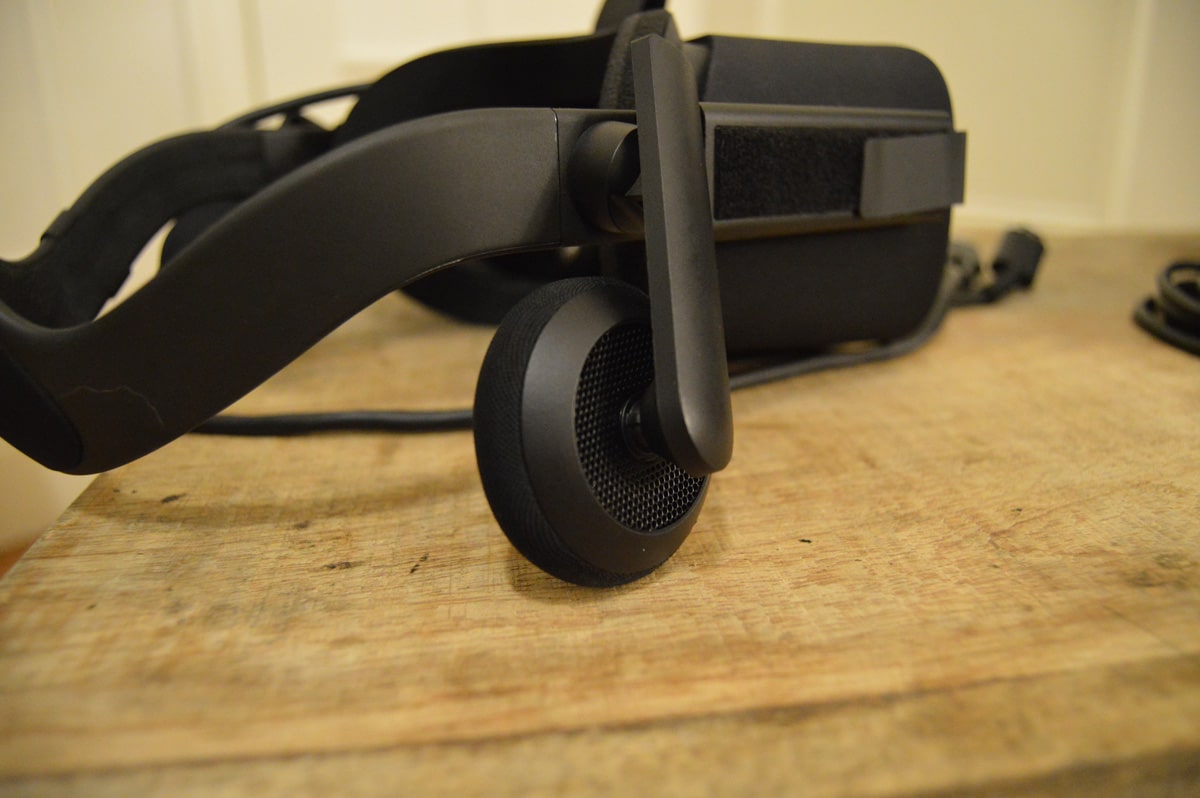
Sound is just as if not more important to creating an immersive VR experience as the display, and because of this Oculus built in a pair of removable high quality headphones into each Rift.
The headphones might not look like much at first, in fact let’s call a spade a spade – they look like the cheap headphones that used to come with a Sony Walkman – but looks can be deceiving. The built in headphones adjust to fit comfortably over the ear and pack a punch with crisp sound and a surprising amount of bass for a compact package.
That said, they are not the highest quality headphones on the market by any means, for example they have quite a bit of sound leakage. Users who wish to use their own headphones for a higher quality experience can remove the built in ones from the headset with relative ease – however there is not a headphone jack built into the headset, so you will have to either use wireless headphones or run an Aux cord from your computer.
In addition to built in sound output, the Rift also has a built in microphone. This allows for easy voice chat, as well as the ability to add voice commands within experiences like Elite: Dangerous.
Positional Tracking Volume and Robustness
One of the biggest recent debates among the VR community is around whether or not the Oculus Rift is capable of tracking ‘room scale’ experiences that require space to move around in. After stress testing the Rift’s positional tracking I found it to be quite robust and extremely large.
https://www.youtube.com/watch?v=l_HlXzELHgo
The Rift’s tracking works by using an infrared camera positioned in front of the user. This camera tracks a set of IR LEDs on the Rift itself, allowing it to determine its position in 3D space. As long as the camera is able to see three of the LEDs on the Rift (which are embedded in and around the display box and on the triangular portion of the back strap) it is able to track it.
For our tracking test I measured out a 12 ft wide by 10 ft long space and placed the camera at the front directly in the middle of the width (this was all laser measured) and positioned the camera with a slight upward facing angle. I then walked, ran, and crawled around that space and found that outside of a few pockets (such as to the left or right of the camera on an even plane) a single camera was able to track that entire playspace.
Based on this experience, and my previous experience with a two camera setup, it seems highly plausible that functional ‘room scale’ is achievable on the Rift with two cameras. That said, a current lack of any sort of chaperone system to prevent one from running into walls makes that experience slightly less than optimal.
Oculus Remote
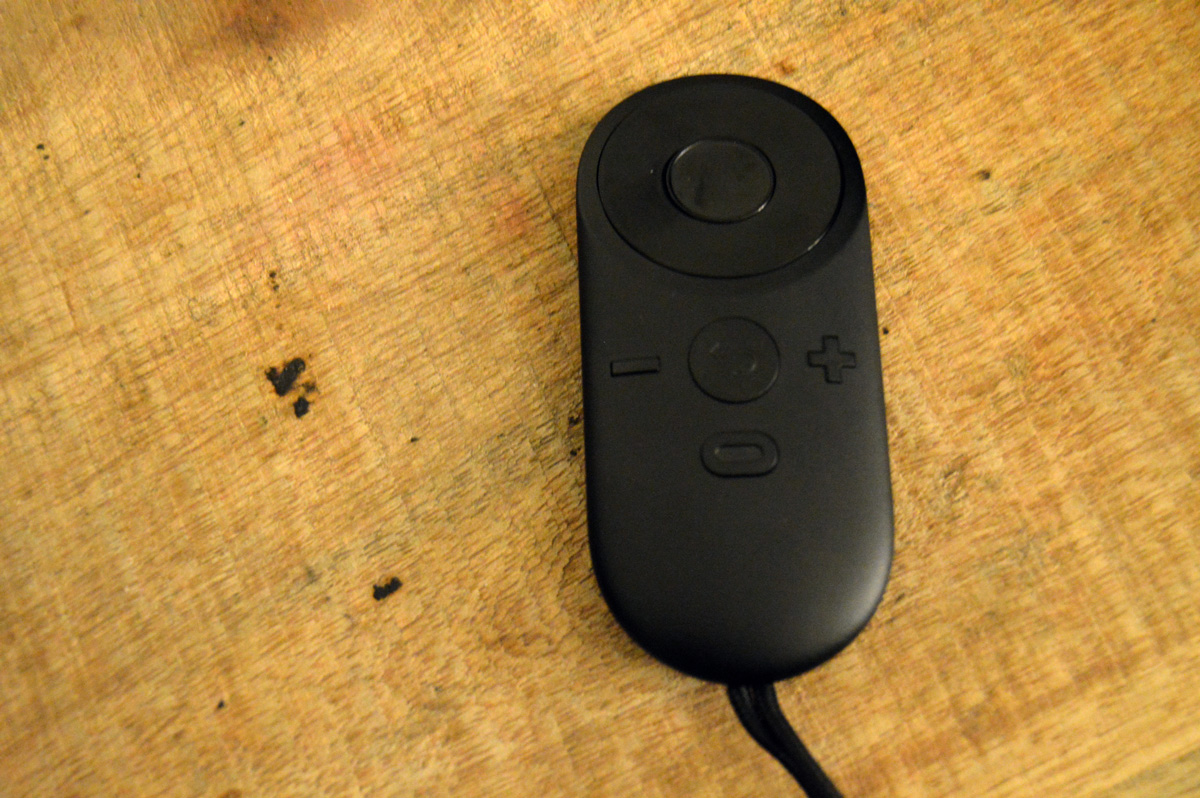
The decision to include an Xbox controller was motivated by the desire to keep a continuity with developers who had been creating Rift experiences for they style of input since the device was announced, but for non gamers handling the controller blind may be a bit difficult at first. That is one of the reasons that Oculus has also included a simple remote with the Rift.
The extremely light Oculus Remote has very basic functionality with nine face buttons: Up, Down, Left and Right, Select, Back, Home and Volume controls. Despite this it can actually be used for more than just navigation, there are several games that you can play with it as well such as: Farlands, Dead Secret, and Defense Grid 2. Experienced gamers may eventually eschew the device completely in favor of their Xbox controller, but the device is great for exploring more passive VR content.
Content
What would a new platform be without content to play? A paper weight.
That is why Oculus put a great deal of investment into making sure that the device launches with a diverse and strong launch library. Everyone who receives the Rift either through pre-order or Kickstarter backing will get a number of pieces of content to play with as soon as they create their account including some two of the best launch titles: Lucky’s Tale and EVE: Valkyrie, as well as a new title from Oculus called Farlands, which will receive daily updates. Outside of games, the Rift comes with experiences like Lost and Henry from Oculus Story Studios and access to apps like Oculus Video which allows you to buy and rent movies to watch in a virtual theater with up to five of your friends.
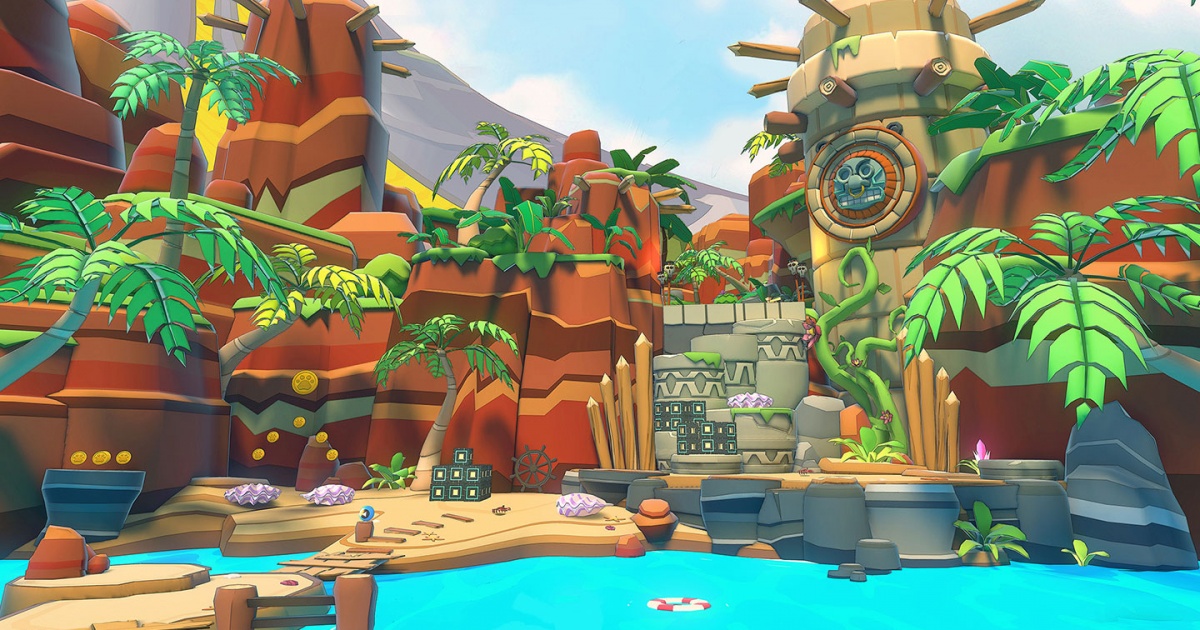
Outside of the content that comes with the Rift there are 28 other games that will be available at launch for purchase. These titles range in price from $9.99 to $49.99 and there are a number of gems among the list such as Chronos ($49.99) and Blazerush ($14.99). There are a lot more games to come throughout the year, as Oculus has promised over 100 titles by year’s end. And as Luckey told us, “If you buy a Rift, you’re not going to run out of stuff to play.”

And while you’re inside playing through the hours of content available, you are likely going to want to do it with friends. Social VR is one of the most powerful things one can do with the medium. It is hard to explain just how much having someone else present within the experience helps to validate its reality. Multiplayer VR is incredibly compelling – to the point that Luckey says that social VR is “the reason Facebook acquired Oculus.”

Oculus’ social SDK has provided developers with the necessary resources to create a number of multiplayer experiences. Out of the Rift’s launch library, one third of the titles have multiplayer functionality – meaning that there will be plenty to experience with others. Mysteriously though, Oculus’ own social app – which recently exited Alpha on Gear VR – is absent from the Rift’s platform. I suspect that won’t remain the case for too long.
Tech Specs and Recommended Hardware
Here is the full list of the Rift’s technical specifications that have been officially confirmed by Oculus:
Headset:
- Orientation sensors: Gyroscope, accelerometer
- Display resolution: 1200×1080 (per eye)
- Display refresh rate: 90Hz
- Lens spacing adjustment: 58-72mm
- Headset cable: 4m custom cable
- Replaceable facial interface
Sensor
- Sensor mount: Integrated stand, 1/4-20 camera mount compatible
- Integrated constellation tracking
- Sensor cable: 2.5m cable
And here are the recommended PC specs:
- Graphics Card: NVIDIA GTX 970/AMD R9 290 equivalent or greater
- Processor: Intel i5-4590 equivalent or greater
- Memory: 8GB+ RAM
- Output: HDMI-compatible 1.3 video output
- Operating System: Windows 7 SP1 64-bit or newer
- Inputs: 3x USB 3.0 ports, 1x USB 2.0
To see if your computer is ‘Oculus ready’ use this tool.
Warranty: Limited one (1) year warranty, except if purchased in the EU which grants a two (2) year warranty.
Touch the Future
A review of the Rift wouldn’t be complete without a look into its near future. Right now, the Rift is poised to be the only headset that won’t have hand tracked controllers available at launch. Rather, Oculus’ Touch controls are poised to launch sometime later this year.
Touch adds an entirely new dimension to the virtual reality experience, bringing your hands into the game. Adding hand tracked controls to a virtual reality experience can greatly increase the level of immersion one experiences within it.
Out of all the available headsets, the Touch controls are currently the most ergonomically superior. Their compact and lightweight design disappears into your hand – making it easy to forget that you are holding a controller in the first place. Additionally they are the only controllers that allow for any kind of finger tracking, allowing simple gestures with your thumb and index finger. Though that functionality may expand by launch.
There will be a number of amazing experiences like VR Sports Challenge and Dead and Buried that will launch with Oculus Touch this year that will likely make it a must own peripheral immediately. In the short term however, the lack of Touch at the Rift’s launch does slightly gimp the headset to start in comparison with the HTC Vive for example but it is far from a fatal flaw as the Rift’s non-Touch launch line up feels strong enough to hold court until later this year.
Concluding Thoughts
I remember the first time that I slipped on an Oculus Rift – it was during the fall semester in 2013 and I had just stepped out of a lecture on Marshall McLuhan’s media ecology theory. I happened to see the first Oculus Rift development kit sitting in the nearly empty math classroom next to mine. I walked in and asked the professor if he would mind if I gave it a try – he said yes and loaded up the Villa demo scene. It was still crude hardware, with a bad ‘screen door effect’ but it showcased enormous potential.
Since that moment I have watched Oculus and the VR industry grow, getting closer each step of the way to the type of product needed to make virtual reality a mass medium. From technology advancements like positional tracking with Oculus’ second development kit to a growing depth of the content available – the Rift has steadily improved over time.
Oculus founder Palmer Luckey has stated multiple times that the company could have released a product much sooner, but Oculus wanted to wait until they had it right – until all the pieces were ready. It was worth the wait. Despite missing hand tracked controllers at launch, Oculus got nearly everything right with the Rift.
The Rift is a masterpiece of industrial and technical design, a product that fits the mass consumer market it seeks. It’s sexy, it’s easy to use, and it works incredibly well. For everything you get, the price feels like a bit of a bargain, but the cost of upgrading one’s computer may cause many customers to wait a bit before taking the plunge.
All in all, however, the Oculus Rift is one of the best new product launches since the iPhone – and it has the chance to be just as impactful. As McLuhan said, “the medium is the message.” Virtual reality is the most personal medium we have ever encountered. It gives us the chance to experience empathy in a literal sense, to see from the perspective of others.
The Oculus Rift is the first step in a long road ahead for consumer VR, but it is a broad one.

